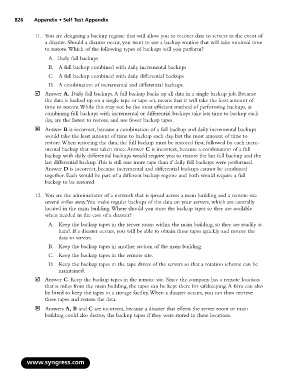Page 842 - StudyBook.pdf
P. 842
826 Appendix • Self Test Appendix
11. You are designing a backup regime that will allow you to recover data to servers in the event of
a disaster. Should a disaster occur, you want to use a backup routine that will take minimal time
to restore.Which of the following types of backups will you perform?
A. Daily full backups
B. A full backup combined with daily incremental backups
C. A full backup combined with daily differential backups
D. A combination of incremental and differential backups.
Answer A. Daily full backups.A full backup backs up all data in a single backup job. Because
the data is backed up on a single tape or tape set, means that it will take the least amount of
time to restore.While this may not be the most efficient method of performing backups, as
combining full backups with incremental or differential backups take less time to backup each
day, are the fastest to restore, and use fewer backup tapes.
Answer B is incorrect, because a combination of a full backup and daily incremental backups
would take the least amount of time to backup each day, but the most amount of time to
restore.When restoring the data, the full backup must be restored first, followed by each incre-
mental backup that was taken since.Answer C is incorrect, because a combination of a full
backup with daily differential backups would require you to restore the last full backup and the
last differential backup.This is still one more tape than if daily full backups were performed.
Answer D is incorrect, because incremental and differential backups cannot be combined
together. Each would be part of a different backup regime and both would require a full
backup to be restored
12. You are the administrator of a network that is spread across a main building and a remote site
several miles away.You make regular backups of the data on your servers, which are centrally
located in the main building.Where should you store the backup tapes so they are available
when needed in the case of a disaster?
A. Keep the backup tapes in the server room within the main building, so they are readily at
hand. If a disaster occurs, you will be able to obtain these tapes quickly and restore the
data to servers.
B. Keep the backup tapes in another section of the main building.
C. Keep the backup tapes in the remote site.
D. Keep the backup tapes in the tape drives of the servers so that a rotation scheme can be
maintained.
Answer C. Keep the backup tapes in the remote site. Since the company has a remote location
that is miles from the main building, the tapes can be kept there for safekeeping.A firm can also
be hired to keep the tapes in a storage facility.When a disaster occurs, you can then retrieve
these tapes and restore the data.
Answers A, B and C are incorrect, because a disaster that effects the server room or main
building could also destroy the backup tapes if they were stored in these locations.
www.syngress.com

